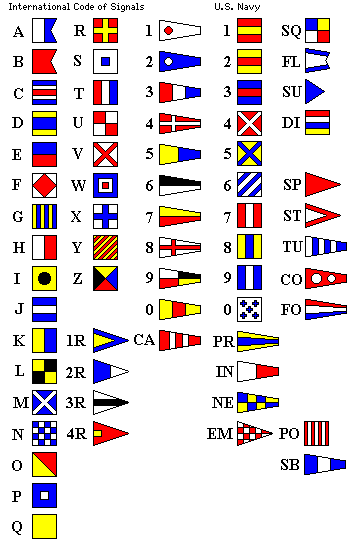
The illustration below illustrates the flags used for the International Code of Signals, and additional flags currently in use by the U.S. Navy and apparently by the British Navy as well:

The flags of the International Code of Signals, although they represent the alphabet, aren't normally used for English-language text. Instead, they are used either to give the call letters of a ship, which are allocated internationally by subdividing the alphabet in much the same way as is used for radio stations, and which are four or five letters long, or for indicating codewords in the International Code of Signals. Codes of one or two letters in length indicate emergency situations, three-letter codewords serve general purposes. Because of the increased ease of radio communications, it appears that the three-letter codes, except for medical codes starting with M, have been removed from the current version of the International Code of Signals. However, some of the two-letter codes may be followed by a digit, called the complement, which adds more specific information.
Some of the flags are named in the illustration by a two-letter abbreviation:
The Repeater/Substitute flags allow any combination of five letters to be hoisted with only a single set of flags: hence, 2R means a duplicate of whatever was signified by the second flag. There are only one of each substitute flag in a set, too; thus, these flags are daisy-chained when necessary. For example:
AXAXA A X 1R 2R 3R AXAXX A X 1R 2R 4R AXAAA A X 1R 3R 4R
The fourth repeater is not a part of the International Code of Signals, but is also one of the additional flags used by U.S. and allied navies; it is, however, placed below the other repeaters in this diagram.
The extra naval flags are the following:
Some other sites which include the U. S. Navy numeric flags are listed below.
I had originally thought the square naval numerical flags were strictly for use in identifying fleets, however, this site which also shows these flags notes that they are the normal flags for the digits in the Navy, with the International Code flags for the numbers having the meanings "Pennant one" rather than "One", and so on. Other references have made it clearer: the Naval numerical flags, like the letter flags of the International Code, are usually used to indicate the numerical codes for phrases, in this case from the Navy Code rather than the International Code. The Flotilla and Subdivision flags, though, are not shown there. The Naval flags are also visible at this page and this site as well. As well, this site notes the fourth repeater as specifically naval. Finally, this site shows the other U. S. Navy flags, besides the numeral flags, that the diagram includes.
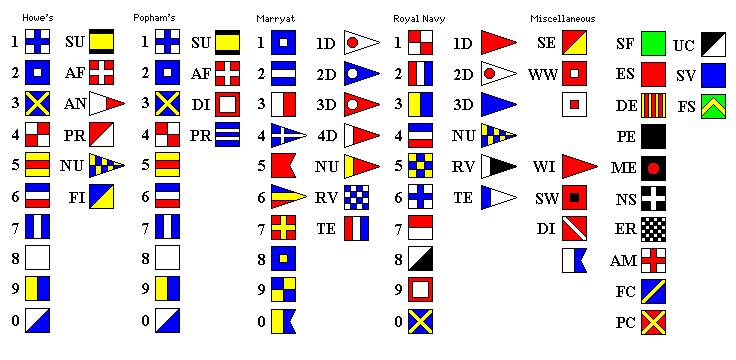
This illustration includes the flags for the signal flag system developed by Lord Richard Howe, and their slight modification for use with a longer code of signals later developed by Sir Home Popham which is often noted as being first used in the famous Battle of Trafalgar involving Admiral Horatio Nelson. However, as will be noted below, he used that code with a different assignment of flags to digits.
Also shown are the flags of the Marryat code, which immediately preceded the current International Code of Signals.
Next, an alternate set of signal flags for use with the Marryat code by the Royal Navy is shown. Supplementary signals for naval purposes were also sent with those flags.
Other flags used with the old British Navy code are:
Other flags used with the Marryat code are:
The distinguishing flags were used as prefixes to the numerical codes for ships, and were added gradually over the life of the Marryat code. Only numbers with no repeated digits were used in the code, so repeaters were not normally required. However, it was noted that the distinguishing flags could be used as repeaters if the flags were used with another code (or with the Numeral flag to indicate a number which happened to have repeating digits) so as to make them necessary.
The Telegraph flag was used to indicate that what was essentially a second code for single words instead of sentences, also provided as part of the Marryat code, was what was to be used for interpreting the hoist.
The Howe code adds flags for some other purposes:
And finally, some flags used for other signalling purposes, but not used as part of a signal flag set (although similar in appearance) appear in the rightmost column of the illustration:
And in the final column, flags used with several different forms of automobile racing:
These last flags are taken from several different forms of racing, from Formula One and NASCAR races to go-kart races; no attempt is made to supply an authoritative reference to the flags used for any one type of automobile race.
The story of Nelson's hoist is more complicated than simply his having used Popham's code. Nelson used a codebook which originally had a somewhat different set of flags than Popham's code, and which had been revised prior to the time of the Battle of Trafalgar due to the belief that the signal flags had been compromised. The two alternatives are shown below:
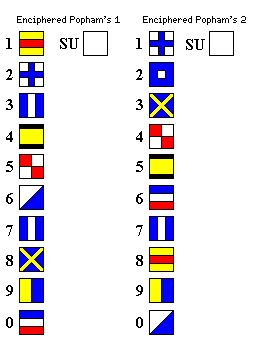
As can be seen, the flags are precisely the same as those in Popham's code, merely assigned to different numbers.
The web site of the Peabody Essex Museum contains a page which illustrates several flag code systems, including some not shown here. One of those, Watson's Holyhead to Liverpool Numeric Flags, interestingly enough, includes the same square Union Jack with a white border that appears in the British Navy code, and the British Navy code also uses the Preparatory flag from Popham's code, as well as most of the same flags as the International Code of Signals, but assigned to different letters. One wonders if naval vessels keep around signal flags from multiple historical systems, leading to an avoidance of making up new flags from scratch.
While the Peabody Essex Museum site has a number of older signal flag systems illustrated, it omitted the one used by Nelson. Although I could not find a table of that code on the web, this site gives the message hoisted by Nelson in its numerical form, and this site includes a picture of the hoist.
Apparently, the British Navy code of Nelson's time required only one substitute flag, as codes requiring a second repeater were omitted.
The Marryat code was in general use among the merchant navies of the world for many years. In 1867, it was replaced by the ancestor of today's International Code of Signals, called the Commercial Code.

It was expected that repeater flags would not be needed with this code, due to the increase in the number of flags used from ten flags to eighteen, so that all signals could be represented with combinations with no repeated letters. The vowels were omitted, not due to fears of playful sailors, but so that the compilers of the signal code book would not have the fear of accidentally overlooking an objectionable three-letter word in some obscure foreign language. The letter B was represented with a flag in a shape called a burgee, and the letters C, D, F, and G were represented by the kind of flag known to baseball fans as a pennant, with the rest of the flags being square flags, so that the shape of the first flag in a group of two or four flags would indicate the type of the signal:
Form of Signal Type of Signal Bx Attention (C-G)x Compass (H-W)x Danger Bxxx Geographical (C-G)xxx Vocabulary (H-W)xxx Ship's Names
Incidentally, the assignment of the first letters of the four-letter designations of ships became the basis of how radio station call letters were also assigned.
Three-letter signals stood for sentences relating to more ordinary occurrences and requests; a four-letter vocabulary signal could indicate an individual word filling in a blank in such a sentence.
In 1901, it was found that the whole alphabet was needed after all; the distinction in shapes between the first few flags was retained. The code as then modified then became known as the International Code of Signals. Then, on the official date of January 1st, 1934, the present-day set of flags was adopted, and repeaters, confusing though they might be to sailors, were required once again. They might have even been more confusing having fallen into disuse (outside of the codes used internally by navies) for over sixty years. Their re-introduction meant that it was no longer possible for some of the letter flags to be pennants, and those flags were therefore altered.
It can be seen on the diagram how the designs used on the flags for C, D, E, F, and G survive in the numeral flags for 1, 2, 3, 4, and 5, although the flags, still called pennants, differ in shape from the classic pendants used for the repeaters.
Since, as noted above, three-letter signals other than medical ones have now been abolished, given the increased use of radio for signalling by ships at sea, it is not likely that the set of signal flags will need to be expanded again to make room for more code groups: one could imagine the next step to be defining a set of 100 flags, each to stand for two digits.
Recently, I noticed an item on a page within Dik Winters' site (the original site is no longer available, but some of the information on it about computer codes is now present at another location) about a signal flag code used by the British Navy of which I had previously been unaware. A little searching turned up this site which has copies of some original illustrations of that code.
Here are these flags, with revisions from the time of the Second World War shown on the right:
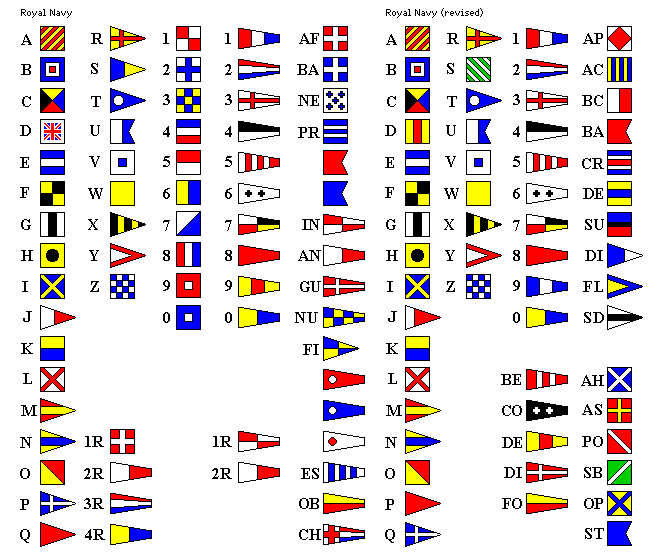
The special flags used with the original version of these signal flags were:
As well, there were red and blue burgees, and red, blue, and white pendants. The red pendant did sometimes also have the meaning of "Compass", to be fair.
For repeaters, flags with other meanings were used; and a different set of flags was used for that purpose with pendants than with other flags.
As revised for World War II, the letters D and S, as well as the pendant for the number 9, gained new flags. As well, the flags for the letters P and Q were interchanged.
While this may be fittingly related to the phrase "to mind one's P's and Q's", it may have happened too late to be its origin; that origin has also been claimed for printing with metal type, as the reversed forms of those letters on the type slugs can be confusing to distinguish, and for the tally of pints and quarts consumed on credit in a British pub, and several other possibilities are also still considered.
The added flags for the World War II set are:
Not shown in the diagram above are oversize solid blue, red, and black square flags, and an oversize solid black pendant (not the kind tapering to a point, but in the general shape of the number flags in the current International Code of Signals).
Of course, it will be noted that many of these flags were flags we would see again in the International Code of Signals, and a few were taken from earlier signal code arrangements as well. In particular, it may be noted with interest that both the Preparatory and Affirmative flags are those used in Popham's code, and the square flags for the numbers 1, 2, 4, 6, 7, and 0 also hearken back to the code that Nelson used at Trafalgar.
Going back somewhat less far, only one of those flags was not in the set of numeral flags used by the Royal Navy in 1854, according to the 12th edition of Marryat's code:
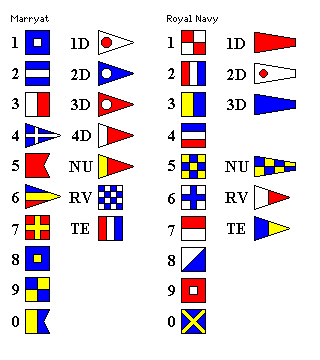
Given that the British Navy had its very own set of signal flags, I think it not unreasonable that the Soviet navy may also have done so during part of its existence, as this site claims, which is referenced by this site which expresses some doubts.
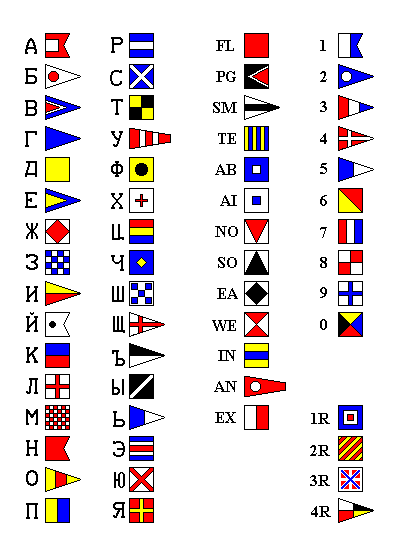
When it comes to the third repeater flag, though, I have to think that one could not make this stuff up. (I later found that it wasn't quite as strange as it seemed to me: the design in the center of the flag was not simply a made-up substitute for the Union Jack, it was Russia's already-existing Naval Ensign.)
The special flags shown here are:
Also from the Flags of the World web site, a description of a German signal flag system is given, which leads to flags that look like those in the following diagram, if I understood it correctly:
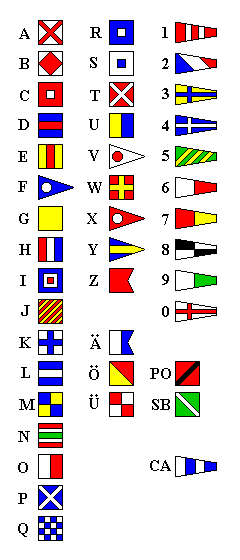
In its satire of the movie The Sound of Music, MAD magazine called our attention to the fact that Austria is a landlocked country. Although this is quite true, the old Austro-Hungarian Empire which existed prior to World War I had both an outlet to the sea and a navy.
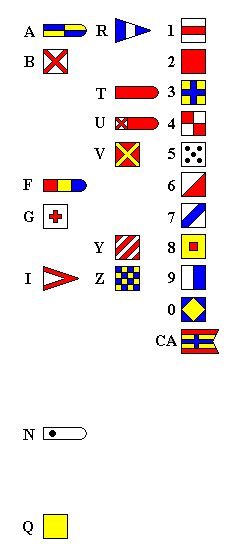
And the signal flags of that navy are shown above. One might note from the design of the flag for the letter G, that this set of signal flags appears to predate the Geneva Conventions.
While on the topic of navies that no longer exist, these are the flags of the Union and the Confederacy in the Civil War:
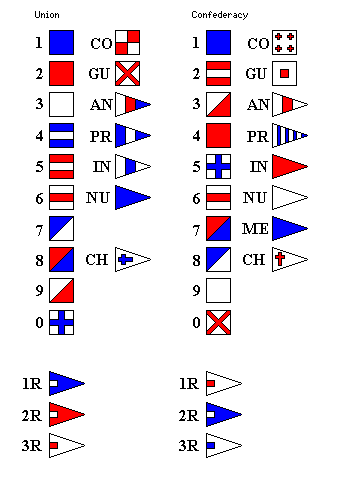
Here, the special flags are:
Copyright (c) 1998, 1999, 2000 John J. G. Savard